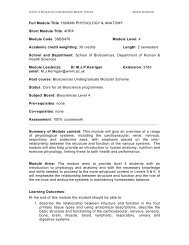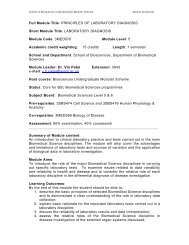CONTENTS 1. Introduction 1.1 Course Outline 1 1.2 Introduction ...
CONTENTS 1. Introduction 1.1 Course Outline 1 1.2 Introduction ...
CONTENTS 1. Introduction 1.1 Course Outline 1 1.2 Introduction ...
You also want an ePaper? Increase the reach of your titles
YUMPU automatically turns print PDFs into web optimized ePapers that Google loves.
(xii)<br />
(xiii)<br />
(xiv)<br />
To educate graduates to be able to undertake post-graduate research and contribute to<br />
knowledge and the development of their chosen fields of study.<br />
To develop communication skills associated with oral and written presentations of<br />
technical work, and interpersonal and organisational skills associated with project<br />
planning, execution and appraisal.<br />
To instil and develop transferable skills.<br />
<strong>1.</strong>4 Rationale for the <strong>Course</strong><br />
The University of Westminster has been at the forefront of education and research in imaging for<br />
many years and remains one of only a few universities in Britain offering study in both the<br />
science and creative practice of all aspects of contemporary imaging. Innovative teaching<br />
programmes have closely paralleled technological change since 1840 when classes in<br />
photography were provided, within two years of the invention of the photographic process, at the<br />
then Royal Polytechnic Institution. In 1896 the first public screening of a motion picture by the<br />
Lumière Brothers took place in a theatre located at 309 Regent Street, which subsequently<br />
became a cinema and is now used by the University as lecture theatres.<br />
The School of Photography flourished over the years and in the 1960s a unique undergraduate<br />
course in Photographic Technology was established. This course was the first degree-level course<br />
in Photography to be offered in the United Kingdom. The course has evolved through several<br />
stages into the current Bachelor of Science.<br />
Imaging is in a state of rapid change and growth. The introduction and now universal use of<br />
computers and associated hardware has created a demand for digital systems. Many industries<br />
and applications areas have already moved away from conventional photographic systems into<br />
the digital domain. Examples include: graphic arts, medical imaging, image archiving, much of the<br />
news gathering areas, particularly for high profile international reporting, earth resources, military<br />
and satellite imaging.<br />
These factors have resulted in the demand for well educated people with the specific high level<br />
skills required to deal with the complex demands of modern imaging. Our graduates have a high<br />
success rate in moving into careers directly related to photography, imaging and imaging science.<br />
Past students have moved into careers in areas as diverse as forensic imaging, applied optics,<br />
commercial photography and advertising, medical imaging and digital special effects.<br />
Opportunities exist within the course for students to develop the creative side of their practice in<br />
photography and imaging alongside the scientific study of the processes involved.<br />
The revalidated course has two distinct emphases in the range of modules offered. This allows<br />
the student to select Option modules at Levels 5 and 6 specialising in practical and applied<br />
photography, such as Applied Imaging II and Advanced Photography Practice; or to take modules<br />
in advanced aspects of imaging science, such as Image Quality and Colour Image Science. The<br />
aim of providing these two specialisms is to produce graduates equipped for the full gamut of<br />
possible careers in imaging, with some students progressing onto the MSc in Digital &<br />
Photographic Imaging also offered by the department, and a career in imaging science; while<br />
others move into applied imaging, such as forensic and medical imaging, or commercial<br />
photography. These options are taught alongside core modules providing students with the<br />
necessary skills and knowledge in photographic science including the theory and practice of<br />
photography, the assessment of images and imaging systems, optics, and visual science. As the<br />
field has developed the course has expanded to encompass principles of digital imaging and<br />
applications such as colour management, multimedia and 3D modelling.<br />
The latest version of the course also includes a core level 5 module in Career Management Skills.<br />
This has been developed by the Careers & Student Employment service and is designed to<br />
implement the University strategies on skills, CEIG (Careers Information, Education and<br />
Guidance), widening participation, employability and retention. The key aim of the module is to<br />
DPI_Hbook 3 ©University of Westminster
















